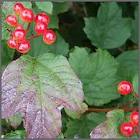The Guelder rose is native to Europe and North America and was introduced to Britain province of Gueldersland
 It is commonly known as Cramp bark as the bark of the tree is used to alleviate spasms of various kinds in traditional systems of medicine across the world. It contains coumarins which affect the uterine muscles and help in menstrual cramps and childbirth. In centuries past the bark has been used in tisanes and decoctions for nervous spasms and asthma, convulsions, palpitations and for the heart.
It is commonly known as Cramp bark as the bark of the tree is used to alleviate spasms of various kinds in traditional systems of medicine across the world. It contains coumarins which affect the uterine muscles and help in menstrual cramps and childbirth. In centuries past the bark has been used in tisanes and decoctions for nervous spasms and asthma, convulsions, palpitations and for the heart.  In
In The trees produce balls of white flowers, before the berries, and these give rise to the name, Snowball tree. Actually it resembles an elder, and the flowers from a distance can resemble those of the elder tree.
 It is the bark of the tree that is used in herbal preparations, and this is either collected in autumn, before the leaves turn yellow or purple, and then it is dried for later use, perhaps to be ground into a powder. Alternatively it is gathered in early spring before the leaf buds open. If you cannot take aspirin, you should avoid any medications made from the Guelder rose.
It is the bark of the tree that is used in herbal preparations, and this is either collected in autumn, before the leaves turn yellow or purple, and then it is dried for later use, perhaps to be ground into a powder. Alternatively it is gathered in early spring before the leaf buds open. If you cannot take aspirin, you should avoid any medications made from the Guelder rose. The bright red berries provide winter food for birds, and a red dye can be prepared from them. A red ink can be made from the dried berries. The Russians used to make a brandy from the berries called nastoika which was used for peptic ulcers. In China Japan
 In the Language of Flowers the Guelder rose symbolizes winter and old age, but in the
In the Language of Flowers the Guelder rose symbolizes winter and old age, but in the The decoction of the bark is potent and you only need to take a tablespoon in a cup of water 3 times a day for cramps. This is made from 1 ounce of dried bark to one pint of water boiled, then simmered for 15 minutes.
 Another remedy and tisane for stomach cramps is to take equal amounts (an ounce of each) of Guelder rose bark, angelica root, and ginger root and three ounces of fresh chamomile leaves and flowers. Pour a litre of boiling water over these and leaves to infuse for 30 minutes, then strain and drink a small cup three times a day.
Another remedy and tisane for stomach cramps is to take equal amounts (an ounce of each) of Guelder rose bark, angelica root, and ginger root and three ounces of fresh chamomile leaves and flowers. Pour a litre of boiling water over these and leaves to infuse for 30 minutes, then strain and drink a small cup three times a day.


Please check your references. Guelder rose was not imported into the UK until several centuries after Chaucer's time. According to my research, "gaitre-berries" refer to the berries of the dogwood, cornus femina.There is no reference to crampbark being used medicinally until the 19th century when Native American practice was brought back by Thomson. and distributed via Ecelctic practic.
ReplyDeleteThanks for sharing this informative information about cramp bark powder with us. It's very helpful. Keep it up!
ReplyDeleteThanks for sharing this informative information about Cramp Bark Powder with us. It's very helpful. Keep it up!
ReplyDelete